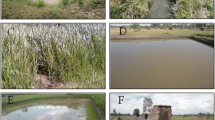Abstract
The New Orleans Mosquito Control Board mass produces Mesocyclops longisetus and Macrocyclops albidus for introduction to mosquito breeding sites as a routine part of control operations. Mesocyclops longisetus is used in tires that collect rainwater; M. albidus is used in temporary pools. Field trials in a Spartina marsh, rice fields, and residential roadside ditches in Louisiana suggest that M. longisetus and M. albidus could be of use to control larvae of Anopheles spp. and Culex quinquefasciatus. Mesocyclops longisetus has proved to be effective for Aedes aegypti control in cisterns, 55-gallon drums, and other domestic containers in Honduras.
Similar content being viewed by others
References
Bonnett, D. D. & T. Mukaida, 1957. A copepod predaceous on mosquito larvae. Mosquito News 17: 99–100.
Brown, M. D., B. H. Kay & J. K. Hendrikz, 1991. Evaluation of Australian Mesocyclops (Copepods: Cyclopidae) for mosquito control. J. med. Entomol. 28: 618–623.
Fryer, G., 1957. The food of some fresh water cyclopoid copepods and its ecological significance. J. anim. Ecol. 26: 263–286.
Hurlbut, H. S., 1938. Copepod observed preying on first instar larva of Anopheles quadrimaculatus Say. J. Parasitol. 24: 281.
Kay, B. H., C. P. Cabral, A. C. Sleigh, M. D. Brown, Z. M. Ribeiro & A. W. Vasconcelos, 1992. Laboratory evaluation of Brazilian Mesocyclops (Copepods: Cyclopidae) for mosquito control. J. med. Entomol. 29: 599–602.
Lardeux, F. J. R., 1992. Biological control of Culicidae with the copepod Mesocyclops aspericornis and larvivorous fish (Poeciliidae) in a village of French Polynesia. Med. Veterin. Entomol. 6: 9–15.
Lardeux, F. J. R., Y. Séchan & B. H. Kay, 1992. Release of Mesocyclops aspericornis (Copepods) for control of larval Aedes polynesiensis (Diptera: Culicidae) in land crab burrows on an atoll of French Polynesia. J. med. Entomol. 29: 371–376.
Lindberg, K., 1949. Crustacés copépodes comme ennemis naturels de larvés d'Anopheles. Bul. Soc. Pathol. Exot. 42: 178–179.
Marten, G. G., 1984. Impact of the copepod Mesocyclops leuckarti pilosa and the green alga Kirchneriella irregularis upon larval Aedes albopictus (Diptera: Culicidae). Bull. Soc. Vector Ecol. 9: 1–5.
Marten, G. G., 1989. A survey of cyclopoid copepods for control of Aedes albopictus larvae. Bull. Soc. Vector Ecol. 14: 232–236.
Marten, G. G., 1990a. Issues in the development of cyclops for mosquito control. Arbovirus Res. Australia 5: 159–164.
Marten, G. G., 1990b. Evaluation of cyclopoid copepods for Aedes albopictus control in tires. J. am. Mosq. Control Assoc. 6: 681–688.
Marten, G. G., 1990c. Elimination of Aedes albopictus from tire piles by introducing Macrocyclops albidus (Copepods, Cyclopidae). J. am. Mosq. Control Assoc. 6: 689–693.
Marten, G. G., 1993. Biological control. In Meek, C. L. & G. R. Hayes (eds), Commercial Pesticide Applicator Mosquito Control Training Manual. Louisiana Mosquito Control Assn., New Orleans: 57–61.
Marten, G. G., R. Astaiza, M. F. Sudrez, C. Monje & J. W. Reid, 1989. Natural control of larval Anopheles albimanus (Diptera: Culicidae) by the predator Mesocyclops (Copepods: Cyclopoida). J. med. Entomol. 26: 624–627.
Marten, G. G., M. Cush, E. Fernández, G. Borjas & H. Portillo, 1992. Mesocyclops longisetus and other forms of biological control for Aedes aegypti larvae in the Integrated Dengue Control Project, El Progreso, Honduras. In Halstead, S. B. & H. Gómez-Dantes (eds), Dengue — a Worldwide Problem, a Common Strategy. Proc. International Conference on Dengue and Aedes aegypti Community-based Control, The Rockefeller Foundation and Ministry of Health, Mexico: 133–137.
Marten, G. G., W. Che & E. S. Bordes, 1993. Compatibility of cyclopoid copepods with mosquito insecticides. J. am. Mosq. Control Assoc. 9: 150–154.
Marten, G. G., G. Borjas, M. Cush, E. Fernández & J. W. Reid, 1994. Control of larval Ae. aegypti (Diptera: Culicidae) by cyclopoid copepods in peridomestic breeding containers. J. Med. Entomol. 31: 36–44.
Reid, J. W. & G. G. Marten, 1994. The cyclopoid copepod fauna of non-planktonic habitats in Louisiana and Mississippi. Tulane Studies in Zoology and Botany 29, in press.
Rivière, F. & R. Thirel, 1981. La prédation du copépode Mesocyclops leuckarti pilosa (Crustacea) sur les larves de Aedes (Stegomyia) aegypti et Ae. (St.) polynesiensis (Diptera: Culicidae): essais préliminaries d' utilisation comme agent de lutte biologique. Entomophaga 26: 427–439.
Rivière, F., Y. Séchan & B. H. Kay, 1987a. The evaluation of predators for mosquito control in French Polynesia. Arbovirus Res. Australia 4: 150–154.
Rivière, F., B. H. Kay, J. M. Klein & Y. Séchan, 1987b. Mesocyclops aspericornis (Copepods) and Bacillus thuringiensis var. israelensis for the biological control of Aedes and Culex vectors (Diptera: Culicidae) breeding in crab holes, tree holes, and artificial containers. J. med. Entomol. 24: 425–430.
Suárez, M. F., 1992. Mesocyclops aspericornis for the control of Aedes aegypti in Puerto Rico and Anguilla. In Halstead, S. B. & H. Gómez-Dantes (eds), Dengue — a Worldwide Problem, a Common Strategy. Proc. International Conference on Dengue and Aedes aegypti Community-based Control, Rockefeller Foundation and Ministry of Health, Mexico: 151–157.
Suárez, M. F., D. Ayala, M. J. Nelson & J. W. Reid, 1984. Hallazgo de Mesocyclops aspericornis (Daday) (Copepods: Cyclopidae) depredador de larvas de Aedes aegypti en Anapoima-Colombia. Biomédica 4: 74–76.
Suárez, M. F., G. G. Marten & G. C. Clark, 1992. A simple method for cultivating freshwater copepods used in biological control of Ae. aegypti. J. am. Mosq. Control Assoc. 8: 409–412.
Vasconcelos, A. W., A. C. Sleigh, B. H. Kay, C. P. Cabral, D. B. Aradjo, Z. M. Ribeiro, P. H. Braga & J. S. Cavalcante, 1992. Community use of copepods to control Aedes aegypti in Brazil. In Halstead, S. B. & H. Gómez-Dantes (eds), Dengue — a Worldwide Problem, a Common Strategy. Proc. International Conference on Dengue and Aedes aegypti Community-based Control, The Rockefeller Foundation and Ministry of Health, Mexico: 139–144.
Author information
Authors and Affiliations
Rights and permissions
About this article
Cite this article
Marten, G.G., Bordes, E.S. & Nguyen, M. Use of cyclopoid copepods for mosquito control. Hydrobiologia 292, 491–496 (1994). https://doi.org/10.1007/BF00229976
Issue Date:
DOI: https://doi.org/10.1007/BF00229976




